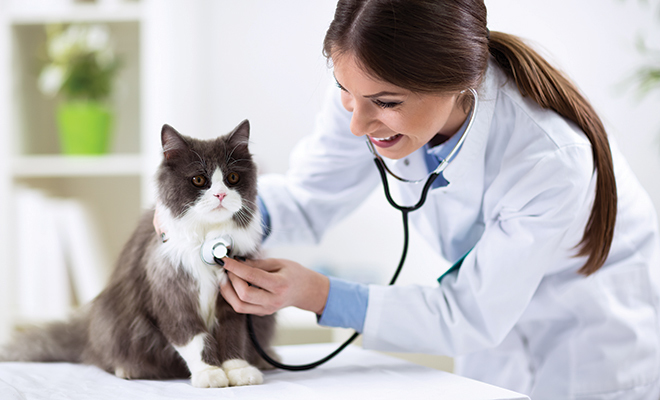
Love your pet, love your vet
Peanut, my handsome 11-year-old tabby cat, didn’t feel well. He changed position frequently and couldn’t get comfortable. As his respirations per minute approached 50, I told him, “You’re going to the vet!”
“The smallest change in an animal’s behavior can be very significant,” notes Dr. Joshua Morgan, associate veterinarian of Britt Animal Hospital, who has poked, prodded and inoculated Peanut over his lifetime. “We all have daily routines with our pets, whether it’s the ones outside or the ones curled up beside us indoors. There are a lot of details in this routine that are huge when it comes to your pet’s health. Sometimes the history an owner gives me about their pet helps me to have a direction in diagnosing better than the actual physical exam.
“I usually tell owners before answering questions to think about what the answer would have been a year ago. Is the answer the same today? One of the most common, obvious things I hear is a change in a pet’s attitude or mobility,” Dr. Morgan continues. “Other things to look for are a change in appetite, drinking and/or urinating more, and an increase in frequency and/or changes in consistency of stools. An owner has to be attentive to pick up more subtle changes, such as hiding or being less social, eating tentatively or dropping food, lying in a different position, and acting differently at night or throughout the day. These are just a few little things that can lead us to an underlying problem.”
As a long-time caretaker of various feline and canine companions, the choice of a veterinarian and a clinic with a professional, compassionate support staff was an important decision for me. Over the years, I’ve confirmed my perception that a good veterinarian is a diagnostician, psychologist, teacher and grief counselor, all in one intuitive individual. With the selection of a veterinarian, I chose to develop a relationship with a doctor, or group of doctors, who would collaborate and communicate with me in caring for a unique creature from the first six weeks of its life to the hard, end-of-life decision.
I’m a no-nonsense communicator, and it was important to know that I would hear not only facts about the health of my pets, but also the truth about a prognosis or a behavior. I’ve observed examinations, inoculations, blood sampling and a few procedures that aren’t for the squeamish. By watching the veterinary professionals handle the pet, I’ve learned valuable techniques for at-home use, such as how to give a cat a pill. Feline owners, I know you recognize that skill.
Dr. Morgan also emphasizes verifying credentials and background. “Always look for a facility and a doctor that has a good reputation,” he advises. “Check online reviews and listen to pet owners you’re acquainted with. I feel like my clients are absolutely my best advertisement.” Inquire about specialized veterinary care; does the facility have access to eye care, orthopedic and other specialists? Do they have the necessary equipment for X-rays, dental care and surgical procedures? Will the staff give you a tour of the facility? Do veterinarians, technicians and staff handle the animals with calm-assertive energy?
Also crucial to communication with your veterinary professional is your role as owner. “There are three things that great pet owners possess: attentiveness, communication and compliance,” Dr. Morgan affirms. “Although some medical and behavioral changes are obvious, it takes closer attention to see more subtle changes. As these changes are seen, I like owners to contact me as early as possible so I can diagnose conditions early and hopefully head off any major issues. The final attribute needed is good compliance. I always tell owners that diagnosing a problem is only half the battle. We have to make sure that the needed treatments can be administered at home. It’s imperative to discuss with the veterinarian if there are any issues with treatment. There are so many options today to formulate medications, and this allows us to find the perfect fit for both the client and pet.”
At Peanut’s veterinary visit, Dr. Randy Britt, the clinic owner who has treated my parade of pets for more years than either of us will confirm, watched as the tabby emerged from his carrier. Peanut looked even more miserable. Doc Randy, as staff and owners call him, began his exam with a stethoscope attached to headphones. “Okay, Marilyn, I want you to take the headphones off my head and put them on so you can hear what I’m hearing.” Ever the teacher, he explained, “That’s a gallop murmur, an indication of cardiomyopathy. It’s not good, and I know that you and I are always in agreement that the comfort of the animal is the most important factor in this situation.”
Yes, I miss my attentive, purring feline. But I know that when I choose to bring another unique companion into my life, she will have the best veterinary care available ■
Sources: merckvetmanual.com and the experience of the author.







